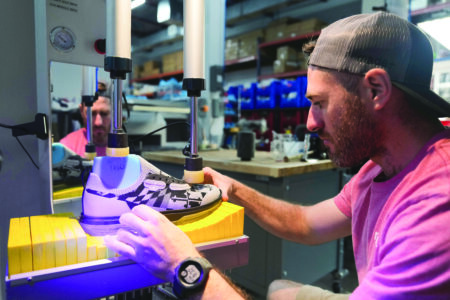Grandparents Teach, too
Money can make sense for children

Sabin, Davis, Hetrick, Anderegg, Macalady, Walker, Darling and Katers
Change jars, heavy change purses and coins discarded around the house can be a source of easy and fun economics activities for young children. One resourceful grandson reported finding five dollars in change just laying around the house.
Econ activities
For this activity you’ll need a container, assorted coins, magnifying glass, paper, and pencil.
To start take out a container of pennies, nickels, dimes, and quarters when your children need a new quiet activity. Make a game out of sorting the coins into piles according to denomination. Younger children will use shape, color and size to determine the correct pile. As you work together, mention the names of the different coins. Line up each type of coin and count how many in each category. Which group has the most coins? Which has the fewest? Count the pennies one by one.
Older kids can practice counting the nickels and dimes by fives and tens. Show how to write the cent and dollar signs.
Use a magnifying glass to study pictures, numbers, and words on coins. What do they mean? Why are they on the coins? New state quarters are especially interesting.
Look in the paper or at stores to see how much things cost. Children can make simple copies of the coins by rubbing over the surface of the metal. Older children will like to play an exchange game where you trade pennies for nickels, dimesfrom a pile of coins. You can play simple games based on “heads or tails.” Cover three coins with cups, one being tails. Move them around and ask children to pick up the cup with the tails coin. Teach children to flip a coin and call heads or tails similar to a football game. Use heads or tails to decide who goes first.
Sorting skills
Sorting things by similarities is a very useful skill for reading, science and math. Teach young children to count by touching each object. By teaching coin names, we are helping children to understand our monetary system. Adults can use this time to talk about how people earn money and how your family uses money to buy things. See through “Savvy Pig” savings banks can help children collect coins. They are divided into save, spend, donate, and invest to help teach children to save and give to charity. When your children have a little money they will be have a better understanding of economics.
Be sure your children know not to put money in their mouths, and continue to watch them. It’s also a good idea to wash hands after handling money. For more economics lessons to help children be successful and reduce the stress of childcare see grandparentsteachtoo.blogspot.com; wnmufm.org/Learning Through the Seasons live and pod casts; Facebook, and Pinterest.
EDITOR’S NOTE: Grandparents Teach, Too is a non-profit organization of elementary and preschool teachers from Marquette, Michigan. The writers include: Jan Sabin, Mary Davis, Jean Hetrick, Cheryl Anderegg, Esther Macalady, Colleen Walker, Fran Darling, and Iris Katers. Their mission since 2009 is to help parents, grandparents, and other caregivers of young children provide fun activities to help prepare young children for school and a life long love of learning. They are supported by Great Start, Parent Awareness of Michigan, the U.P. Association for the Education of Young Children, Northern Michigan School of Education, the Upper Peninsula Children’s Museum and the Northern Michigan University Center for Economic Education.





